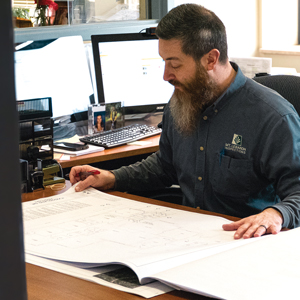Craftsman Revival

ohn and Sharon Riesmeyer had a problem. They agreed that they wanted to move their family from Bethel Park to Mt. Lebanon. Sharon loves old houses with interesting architectural detail and lots of character. But John wanted a new house.
“I’m a lover of charm and old, and he’s a big-and-new kind of guy, so we were butting heads all the time,” Sharon said. Their Realtor showed them a selection of both new and old in Mt. Lebanon, but they couldn’t agree on what to buy.
“We looked forever and ever in Mt. Lebanon—I feel like I saw 200 houses,” said Sharon, who grew up next door in Baldwin Township. “We had lived in other places but I felt like Mt. Lebanon was calling me. I loved the walkability, the housing stock, the trees. It is unique in this area.”
The solution? They built a brand-new house in a historic style in 2010. The Craftsman-style house on Jefferson Drive has five bedrooms and four and a half bathrooms. Sharon, an artist and designer, did the interior design herself, with the aid of a lot of photos she had taken of houses she loved, local architectural design resources and her own good eye.
John, a former currency trader, credits his wife for the historically accurate interiors. “I was involved a little with the things I thought were necessary, like a usable basement and high ceilings. But the design, the thought, everything else was Sharon.”
“We found a house for sale on a double lot,” said Sharon. “We just bought the lot, which had had a swimming pool on it. It took us two and a half years to build. An architect friend, Todd Peters of Bethel Park, helped us design it. We saw what he came up with and we were happy with it. We were also helped by some other craftsmen.”
Her husband concurs. “We found a builder, Jeff Barcellino, who was in charge of all the woodwork as well. He’s a very good carpenter.”
What is Craftsman style? American Craftsman style is a domestic architectural style inspired by the Arts and Crafts movement, which began in Great Britain in the last years of the 19th century. The style remained popular into the 1930s. The movement emphasized handwork over mass production in both architecture and decorative arts, such as tiles, pottery, and woodwork.
In architecture, the style incorporated a visibly sturdy structure of clean lines and natural materials. Common features include deeply overhanging eaves, low-pitched roof lines, exposed rafters, wide front porches, and shingle roofs.
Interiors often feature open floor plans, built-in cabinetry and bookcases, the use of natural materials like wood, brick, and stone, and a color scheme of earth tones.


Fitting into the Neighborhood
The house needed to be large enough for four children—Amanda, now 25; Abby, 23; Drew, 18; and Anna, 14—and several pets. Plus it was important to the Riesmeyers that it fit into the neighborhood, most of which dates from the 1920s and ’30s. Although the scale is larger than the adjacent houses, the style they chose works well with the other homes in the area.
When it came to the design, Sharon relied on her collection of notes and photos that she’d taken on walks around different areas of Hoboken, New Jersey, where they had lived previously, and Pittsburgh, including Squirrel Hill and Shadyside. “I had a phone full of photos of old homes I admired,” she said. “I did some research because I wanted to capture certain things about them. The Craftsman style seemed to fit the neighborhood more than some of the other, older styles, like Victorian. So it was a little bit about blending, a little bit about ‘I like this style,’ and a little about it was probably easier to reproduce than a lot of styles.”

Sharon took advantage of resources all over western Pennsylvania, including Architectural Emporium, an architectural salvage service in Canonsburg, and Ceramiche, a specialty ceramic tile dealer in the West End. She followed Craftsman style in the interiors, specifying woodwork of oak, built-in seating and other features, wood paneling, and period light fixtures.
The entrance off the front porch features Craftsman-style windows on either side of the front door. She found a stained glass window she loved and had it split into three by Williams Glass in Castle Shannon. Those windows, now featured prominently in one wall of the dining room, and the handsome carved newel post in the front hallway are the only antique architectural pieces in the house. Everything else was new but in the Craftsman style.

Built for Kids and Pets

Arriving from the front porch, the visitor passes into a front hall with the dining room to the left and a small office on the right. Behind the office is the family room with a working fireplace, comfortable couches, and glass doors that lead to an outside patio. “This room always has a lived-in look,” Sharon said dryly, referring to the wear and tear inflicted by four children, a dog, and two cats. Surrounding the fireplace is an arrangement of historically accurate tiles, and there are glass-fronted built-in bookshelves on either side of the mantel.
Directly ahead from the front hall is a paneled breakfast nook with built-in benches. Adjacent to the breakfast area is a modern kitchen with a work island, classic wood cabinets, and tile work in muted colors. A hallway off the kitchen leads to a mud room with storage and the exit to the double garage.
Upstairs are the bedrooms, including the master bedroom which leads out to a small balcony overlooking the yard. Now that two of her children are out of the house, Sharon uses a corner bedroom with natural light as her studio; she does paintings of houses and dogs on commission. There are two more bedrooms on the third floor.
The basement is a completely finished second family room, with a full bathroom.

The Satisfaction of Compromise
Ultimately, the Riesmeyers each got what they wanted. “In the end it made my husband happy and it makes me happy as well,” said Sharon. “The scale is all my husband because he likes big things. I very much enjoy the features I was able to add to sort of make it feel like a nice Mt. Lebanon house.”
“Our son loves the front porch and spends time there,” said John. “The biggest thing for me was that the older girls were able to have lots of friends over and they were comfortable coming here, and we had a space in the basement that allowed them to not be around us exactly.”
Sharon said “I love the things that make it unique. I love that stained glass window in the dining room, I love the way the light comes in. There are times when I think we should downsize because we only have two kids living here now, and soon they’ll be out the door. But I have my studio here. And I feel I’ve invested too much sweat in this place to leave it.”





